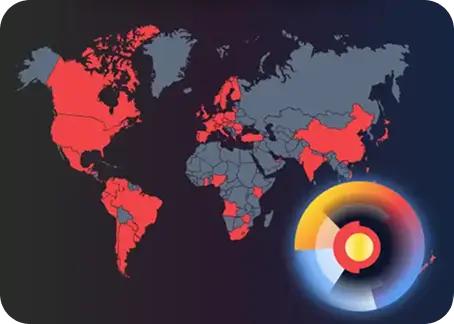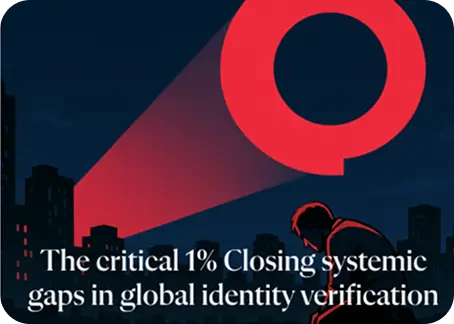Adverse Media Screening

- 01 What Is Adverse Media?
- 02 Where Does Adverse Media Come From?
- 03 Key Sanction and Watchlists
- 04 Why Is Adverse Media Screening So Important?
- 05 Challenges of Manual Screening
- 06 The Role of Automation in Adverse Media Screening
- 07 Combining Technology with Expert Oversight
- 08 What’s Changing in Adverse Media Screenings
- 09 Final Thoughts
Preventing financial crime starts well before a deal is signed or a client is onboarded. Around the world, companies are under growing pressure to scrutinize who they work with, whether customers, suppliers, or strategic partners, to avoid exposure to illicit activities. One of the most powerful risk mitigation techniques is adverse media screening, which helps uncover early warning signs of potential criminal behavior.
What Is Adverse Media?
Adverse Media refers to any publicly available negative information about an individual or organization. This content, whether it is available on digital platforms, traditional news outlets, or informal online sources (such as blogs and social media), can signal involvement in unlawful or unethical behavior. Screening for adverse media allows businesses to identify hidden risks that may not show up on regulatory watchlists or other official records.
Common Types of Adverse Media
Some of the categories often flagged during risk assessment include:
- Financial Crime: These are acts such as money laundering, bribery, fraud, tax evasion, embezzlement, or insider trading.
- Human and Drug Trafficking: Includes illegal transportation of individuals or narcotics across borders. Media coverage may reveal associations with forced labor or international criminal networks.
- Terrorism or Extremism: Links to terrorist organizations or the financing of extremist groups are major red flags and are often tied to broader money laundering schemes.
- Property Crime: Activities such as theft, burglary, or destruction of property can indicate a pattern of criminal behavior.
- Cybercrime and Digital Fraud: Includes identity theft, synthetic identity creation, phishing scams, account takeovers, and the use of stolen financial data.
Where Does Adverse Media Come From?
Adverse media screenings gather insights from a broad range of credible sources. These include:
- Traditional News Outlets: Global and regional newspapers, magazines, radio, and TV networks frequently publish investigative reports that expose criminal or highly unethical conduct.
- Online platforms: Websites, forums, and digital media companies often uncover misconduct significantly faster than their traditional counterparts.
- Social Media: Real-time content platforms like Facebook, Linkedin, and Instagram can surface reputational risks that, while not necessarily verified, are still critical to know.
- Blogs and Forums: While not always reliable, these sources are able to provide early warning signs of suspicious activities, especially within niche sectors or regional markets.
Structured and Unstructured Sources
Adverse media data falls into two main categories:
- Structured Sources: These include official sanctions lists, regulatory databases, and government-published records.
- Unstructured Sources: These involve less formal content like online articles, opinion pieces, and social media posts. Advanced technology is often required to analyze this data in any meaningful way.
Key Sanction and Watchlists
While adverse media goes beyond official lists, combining both provides a fuller picture of potential risk. The most commonly referenced lists include:
-
- OFAC Sanctions List (U.S. Treasury Department)
- Her Majesty’s Treasury (HMT) Financial Sanctions List (UK)
- United Nations Consolidated Sanctions List
- EU Sanctions Map
- Global Regulatory Databases: These track fines, penalties, and enforcement actions from financial authorities around the world.
What Is Adverse Media Screening?
Adverse media screening is the process of reviewing publicly available information about a person or business to identify signs of criminal or unethical behavior. It plays a significant role in a company’s Anti-Money Laundering (AML) and Know Your Customer (KYC) compliance framework.
When businesses screen clients, vendors, or partners against adverse media sources, they can assess risk levels and determine whether to proceed with onboarding, escalate due diligence, or decline onboarding altogether.
Types of Adverse Media Screening
- Initial Due Diligence: Performed during onboarding or relationship evaluations.
- Ongoing Monitoring: Continuous scanning for new adverse media to update risk profiles in real time.
Why Is Adverse Media Screening So Important?
Associating with individuals or organizations that conduct or are involved in illegal activities can significantly damage an organization’s reputation and lead to regulatory scrutiny/penalties. Regulatory bodies worldwide, including the Financial Action Task Force (FATF), strongly encourage adverse media screening as part of a robust AML program.
Benefits of Adverse Media Screening:
- Uncover Hidden Risks: Media content can reveal major misconduct missed in official documentation.
- Maintain Regulatory Compliance: Supports AML, KYC, and counter-terrorist financing efforts.
- Safeguard Business Integrity: Protects an organization’s reputation by preventing association and partnerships with known or suspected criminals.
Challenges of Manual Screening
Manual adverse media screening is immensely time-consuming, prone to human error, and ineffective at scale. Considering the sheer volume of data published daily, and even hourly, relying solely on analysts to review content creates insurmountable delays.
Limitations of Manual Processes:
- Incomplete data coverage
- Slow turnaround times
- Inconsistent risk assessment
- Difficulty handling multilingual content
The Role of Automation in Adverse Media Screening
To meet evolving compliance standards, companies are increasingly adopting AI-powered adverse media screening tools. These platforms use machine learning to scan large quantities of structured and unstructured content in real time.
Key Features of Automated Screening Tools:
- Real-Time Monitoring: Detects negative media coverage as it is happening.
- Multilingual Support: Processes news sources around the world in multiple languages.
- Risk Categorization: Classifies media by risk type, severity, and source reliability.
- Integration with KYC/AML Systems: Connects with existing onboarding and compliance platforms seamlessly.
Combining Technology with Expert Oversight
While automation enhances speed and coverage, human analysts remain essential for context and judgement. An approach to adverse media screening should include:
- Automated alerts for immediate risk detection
- Expert review for complex or ambiguous cases
- Human re-screenings for high-risk clients
This hybrid model ensures accuracy, efficiency, and regulatory alignment, especially when monitoring high-risk clients or politically exposed persons (PEPs).
What’s Changing in Adverse Media Screenings
As adverse media screening continues to evolve to keep up with global threats, regulatory updates, and technological innovation, some key updates include:
- Expanded FATF Guidance: The FATF now encourages member states to apply adverse media screening to fintechs, crypto firms, and designated non-financial businesses and professions (DNFBPs), not just financial institutions.
- AI Advancements in Screening Tools: Platforms now use generative AI and large language models to interpret unstructured media more accurately, including false positives, tone, and context.
- Real-Time Monitoring Requirements: Continuous adverse media monitoring is becoming a compliance expectation for high-risk sectors, replacing outdated batch-based screening cycles.
- Cross-Border Risk Mapping: Tools now factor into jurisdiction-specific media freedom indexes and enforcement transparency to increase screening accuracy in low-disclosure regions.
Final Thoughts
Adverse media screenings are absolutely essential to safeguarding organizations while navigating complex regulatory environments and expanding global partnerships. It enables teams to make informed decisions by revealing reputational and compliance risks that are not found through official records.
As threats grow more sophisticated and data becomes impossible to manage manually, the importance of using intelligent, adaptive tools continues to rise. Organizations that invest in efficient screening processes not only reduce their exposure to financial crime but also strengthen long-term trust with regulators, clients, and the public. In a landscape shaped by speed and scrutiny, proactive risk detection is no longer optional.



